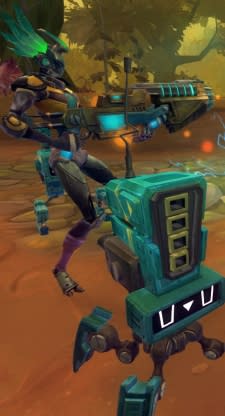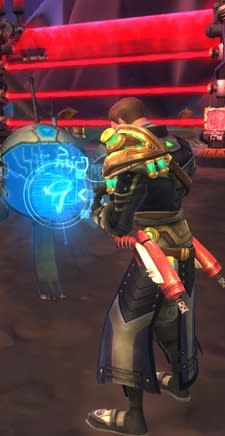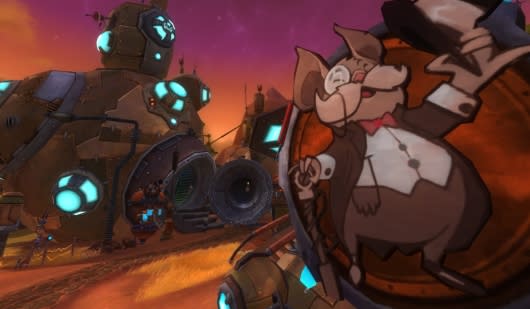A look at WildStar's crafting mechanics
As WildStar nears its ambiguous-but-soon release date, questions have to be asked, aside from "when is this game releasing, anyway?" Like crafting-related questions. Why haven't we heard more about crafting yet? What are the mechanics? Is this another example of a game wherein crafting is just a matter of assembling a pile of materials and clicking a button?
The answer to that last one is a pretty firm no. As it happens, there's a lot going on under the hood of WildStar's crafting mechanics, enough to intrigue dedicated crafters of many styles.
We had a chance recently to sit down with system designer Phillip Chan to talk in-depth about the game's crafting mechanics and how the team is working to keep crafting relevant through the whole game, from start to finish. The goals were to create crafting mechanics that rewarded players for taking part, gave room for custom creations and specialized crafters, and to make the whole thing feel fun. The net result? Not just clicking a button and going off to make a sandwich.

Crafting professions are divided into two types. The first type utilizes circuit board crafting, which is for weapons, armor, and other equipment. All players can customize the stat layout of their items to a limited extent, but circuit board crafting allows the crafter to control the entire schematic, where stats go in the item, balancing out the power needs of the item with the stats being slotted in. Someone crafting a sword could provide much more specialized stats than would be found on a dropped sword, for example -- especially if the crafter opted to overcharge the item.
Overcharging is meant to be a way for crafters to push the strength of an item by introducing a chance of failure, upping power while having a chance at losing the materials and failing the craft. Currently, the ceiling for failure chance is at 30%, but it may increase in the future. No one will ever be forced to overcharge an item, but those who do will be rewarded with more powerful results.
The other major crafting type uses coordinate crafting, which is used for housing items, consumables, and so forth. A Cartesian coordinate grid is displayed, with a handful of points displayed on the grid. Players have three tries to try and move the craft from the starting point to one of the alternate points on the grid, each of which produces a variant on the core schematic. So instead of producing a single-shot healing item, a player could produce one with a heal-over-time effect, or a bloom-style effect with smaller healing over time followed by a big heal at the end.
In both cases, the standard result for a craft isn't meant to be bad. If you don't manage to hit an alternate target during coordinate crafting, you still wind up with the base item. Some of the alternative targets are strictly better than the base item, restoring more health; others are simply flavorful shifts that aren't better, just different. But you're never forced to churn out the same item, over and over, with no space for actual gameplay.
The tech tree is meant to contribute to that. Each craft has its own specific tech tree, with a series of boxes that each contains a task, like "Craft seven healing doodads" or "Build two swords with Attack +10" and points related. (These are simply examples, obviously.) Completing these points on the tech tree rewards players with new recipes. You don't have to complete the tech tree, but the goal is that you don't level crafting simply by assembling a huge stack of materials, clicking the craft button, and then getting up from the computer to go have lunch.

Dedicated crafters also won't be producing the same thing as other dedicated crafters with the same profession thanks to the crafting talent trees. Yes, as you level a craft you get to invest points in crafting talents, diversifying your abilities and allowing you to make even better items in your chosen field than non-specialists. A generic weaponcrafter could build an overcharged sword, for instance, but a dedicated swordsmith could overcharge it further and more efficiently, adding extra stats and even special effects that normally wouldn't be possible.
So how much will all of this matter at endgame? According to Chan, that's still under heavy discussion. At this point everything is tradeable between players -- the goal is an active economy, and that requires crafters who can specialize and trade with others. Where crafted items fall in relation to endgame equipment is still being discussed and tweaked, but the goal has always been that you should be rewarded for taking part in crafting, and that means producing useful stuff at all tiers of gameplay.
Chan also stressed that crafting isn't an afterthought in leveling, either. Schematics exist across the world that are aimed toward what you're doing, so taking part in PvP combat will yield more PvP-related recipes. You also have access to work orders in each major settlement, more incentive to craft a few specific items rather than just mass-producing whatever requires the smallest amount of material.
As it stands now, it seems that crafting will be a fairly major component of WildStar -- not a mandatory one, but something useful from the start of the game into the endgame. Which means you'd better start thinking about how you'd like to specialize your developments. (We recommend specializing in high-quality furnishings. Everyone always needs chairs.)


